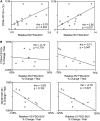Fasting 2-deoxy-2-[18F]fluoro-D-glucose positron emission tomography to detect metabolic changes in pulmonary arterial hypertension hearts over 1 year
- PMID: 23509326
- PMCID: PMC3960991
- DOI: 10.1513/AnnalsATS.201206-029OC
Fasting 2-deoxy-2-[18F]fluoro-D-glucose positron emission tomography to detect metabolic changes in pulmonary arterial hypertension hearts over 1 year
Abstract
Background: The development of tools to monitor the right ventricle in pulmonary arterial hypertension (PAH) is of clinical importance. PAH is associated with pathologic expression of the transcription factor hypoxia-inducible factor (HIF)-1α, which induces glycolytic metabolism and mobilization of proangiogenic progenitor (CD34(+)CD133(+)) cells. We hypothesized that PAH cardiac myocytes have a HIF-related switch to glycolytic metabolism that can be detected with fasting 2-deoxy-2-[(18)F]fluoro-d-glucose positron emission tomography (FDG-PET) and that glucose uptake is informative for cardiac function.
Methods: Six healthy control subjects and 14 patients with PAH underwent fasting FDG-PET and echocardiogram. Blood CD34(+)CD133(+) cells and erythropoietin were measured as indicators of HIF activation. Twelve subjects in the PAH cohort underwent repeat studies 1 year later to determine if changes in FDG uptake were related to changes in echocardiographic parameters or to measures of HIF activation.
Measurements and results: FDG uptake in the right ventricle was higher in patients with PAH than in healthy control subjects and correlated with echocardiographic measures of cardiac dysfunction and circulating CD34(+)CD133(+) cells but not erythropoietin. Among patients with PAH, FDG uptake was lower in those receiving β-adrenergic receptor blockers. Changes in FDG uptake over time were related to changes in echocardiographic parameters and CD34(+)CD133(+) cell numbers. Immunohistochemistry of explanted PAH hearts of patients undergoing transplantation revealed that HIF-1α was present in myocyte nuclei but was weakly detectable in control hearts.
Conclusions: PAH hearts have pathologic glycolytic metabolism that is quantitatively related to cardiac dysfunction over time, suggesting that metabolic imaging may be useful in therapeutic monitoring of patients.
Figures







References
-
- Humbert M, Sitbon O, Chaouat A, Bertocchi M, Habib G, Gressin V, Yaïci A, Weitzenblum E, Cordier JF, Chabot F, et al. Survival in patients with idiopathic, familial, and anorexigen-associated pulmonary arterial hypertension in the modern management era. Circulation. 2010;122:156–163. - PubMed
-
- Toblli JE, Lombraña A, Duarte P, Di Gennaro F. Intravenous iron reduces NT-pro-brain natriuretic peptide in anemic patients with chronic heart failure and renal insufficiency. J Am Coll Cardiol. 2007;50:1657–1665. - PubMed
-
- Sztrymf B, Souza R, Bertoletti L, Jaïs X, Sitbon O, Price LC, Simonneau G, Humbert M. Prognostic factors of acute heart failure in patients with pulmonary arterial hypertension. Eur Respir J. 2010;35:1286–1293. - PubMed
Publication types
MeSH terms
Substances
Grants and funding
LinkOut - more resources
Full Text Sources
Other Literature Sources
Medical
Research Materials

